After years of preparation, a team of Georgia Tech students will shepherd the Lunar Flashlight spacecraft around the moon in search of frozen water.
In August, Georgia Tech’s Lunar Flashlight team received news that was both exhilarating and daunting. Their briefcase-sized satellite was catching a ride on a SpaceX Falcon 9 rocket four months sooner than scheduled.
Suddenly the team of researchers and students found themselves ramping up preparations for a journey to the moon in search of frozen water at the lunar south pole.
Officially, Lunar Flashlight is a NASA Jet Propulsion Lab (JPL) mission. But the actual execution happens right off North Avenue, from the first critical contact after the satellite is released from the rocket to collecting data this spring during 10 or more orbits of the moon. The science mission will scan the area near the moon's south pole using infrared lasers, peeking into craters that have not seen sunlight for billions of years and where scientists have long thought frozen water may exist at the surface.
(text and background only visible when logged in)
What is Lunar Flashlight?
NASA long has been studying ice on the moon. This small spacecraft could finally provide definitive answers about where it is and just how much is there.
How? Using four infrared lasers, Lunar Flashlight will scan the permanent shadows in craters at the moon's south pole, where scientists think previously unseen ice could exist.
(text and background only visible when logged in)
The team will operate the months-long mission — around the clock, from launch to completion — from a small lab near Tech Tower.
Preparations this fall for that responsibility included writing hundreds of pages of documentation, operations scripts, and applications and completing five dry runs called Operational Readiness Tests. The team of student mission controllers ran through trials of the first critical contacts, the scientific experiments during lunar orbit, and even “off-nominal” launches — space industry parlance for a launch that doesn’t go exactly to plan. The team also gathered for hours-long reviews with NASA and JPL to prove they are ready for the mission.
In September, Georgia Tech packed up Lunar Flashlight and trucked it to the Marshall Spaceflight Center in Huntsville, Alabama, where it was fueled and checked one last time.
In November, JPL drove the small spacecraft to Kennedy Space Center in Florida, where SpaceX took possession of the satellite and loaded it into the Falcon 9 payload processing area.
On Dec. 11, in the pre-dawn hours, that rocket will leave Earth and Lunar Flashlight will head to the moon thanks to a series of instructions and commands from Georgia Tech.
Editor's note (Dec. 7): After several rounds of delays, SpaceX has announced a new target launch date of Dec. 11 at 2:38 a.m. ET.
(text and background only visible when logged in)


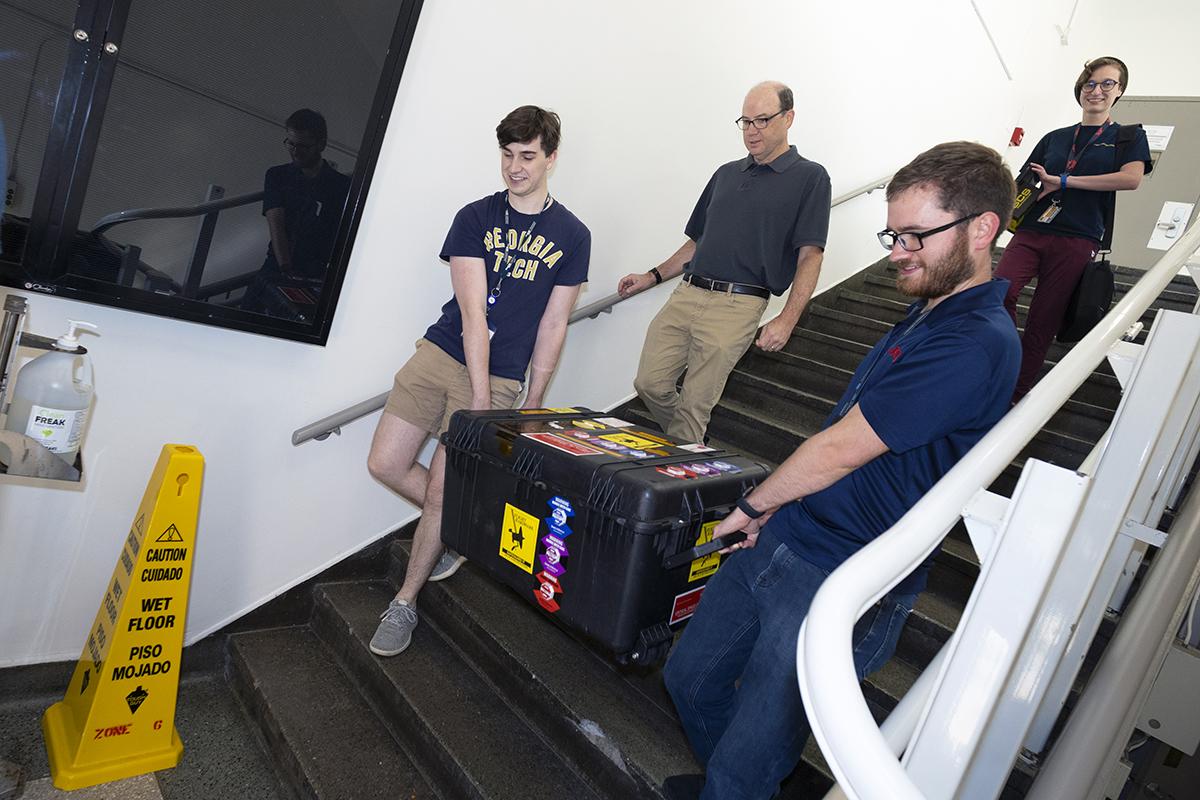
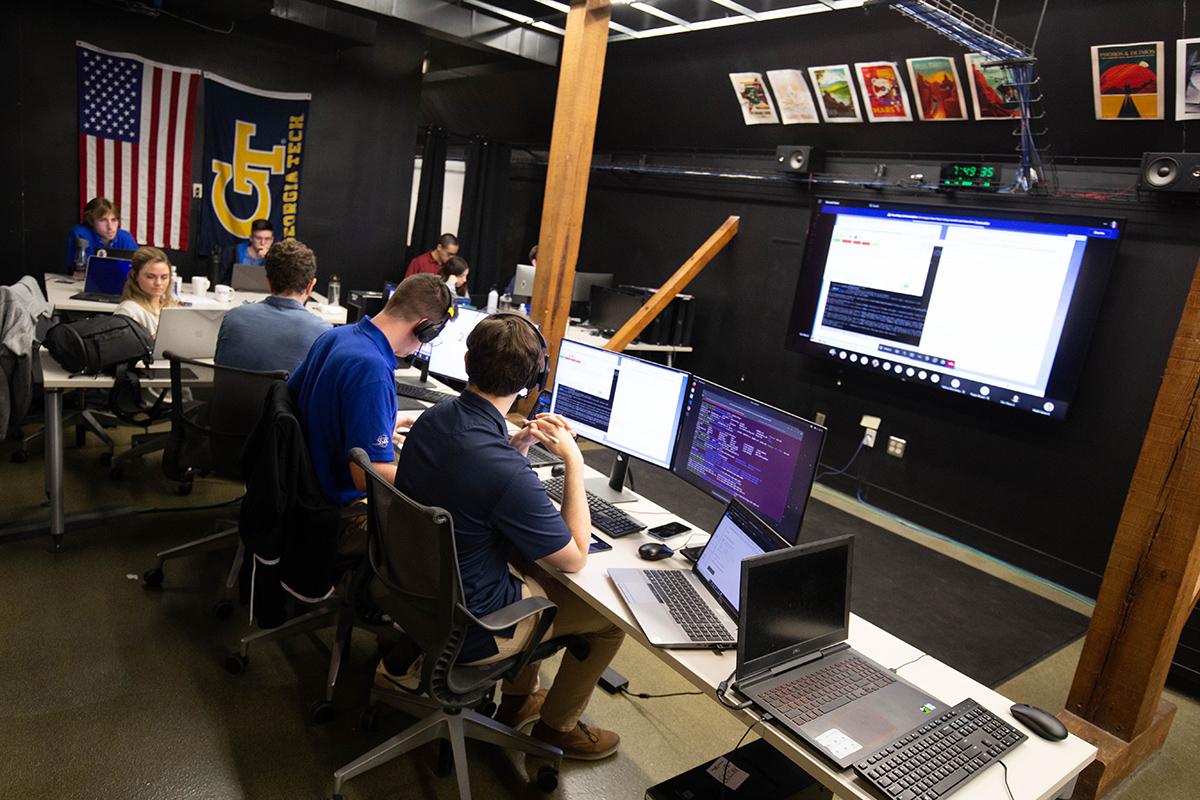
During the last year, Georgia Tech faculty and students integrated and tested the Lunar Flashlight spacecraft and propulsion system, then packed and shipped it to the Marshall Space Flight Center in Huntsville, Alabama. At Marshall, Lunar Flashlight was fueled for its mission to the moon and checked out one last time. The team is now ready to operate the spacecraft from mission control at Georgia Tech.
(text and background only visible when logged in)

(text and background only visible when logged in)

Courtesy: SpaceX
The irony of taking on the responsibility for mission operations is that all the Georgia Tech students and researchers, who have worked for more than a year on the project, can’t travel to Florida to watch Lunar Flashlight launch. They have to be in Atlanta because some of the most critical steps of the mission happen in the first hours after the SpaceX Falcon 9 lifts off from Kennedy Space Center.
Also in mission control: The researchers who’ve led Georgia Tech’s Lunar Flashlight work. Professor Glenn Lightsey’s team in the Daniel Guggenheim School of Aerospace Engineering designed and built the propulsion system pushing the spacecraft to deep space and around the moon. Jud Ready, principal research engineer at the Georgia Tech Research Institute and an adjunct professor in the School of Materials Science and Engineering, has been the project’s principal investigator at Tech. He led integration of the propulsion system with the satellite’s scientific instruments and support subsystems along with subsequent testing.
(text and background only visible when logged in)
Click and drag to explore the Lunar Flashlight spacecraft from every angle. The Georgia Tech-designed propulsion system is on the end with the solar panels. The crater-scanning laser and detector are the square and octagonal openings on the flat side. (Courtesy: NASA/JPL-Caltech)
(text and background only visible when logged in)
(text and background only visible when logged in)
(text and background only visible when logged in)
(text and background only visible when logged in)
Mission control at Georgia Tech is staffed by a group of 14 operators — eight graduate students and six undergraduates.
Each undergraduate is paired with a graduate student mentor, who oversees their training and shadowing for the four critical mission operations positions.
(text and background only visible when logged in)
Spacecraft Link Engineer
This is the controller in contact with Lunar Flashlight. The spacecraft link engineer is responsible for entering and sending commands to the satellite during active operations.
Telemetry Engineer
This controller monitors the hundreds of data points Lunar Flashlight transmits to mission control during contacts. The telemetry engineer has a set of acceptable ranges for each data point — temperature, propulsion, payload, and more — and must alert the mission planner immediately if the spacecraft reports values outside those ranges. The telemetry engineer also performs trending analysis to model the spacecraft's power and thermal characteristics.
(text and background only visible when logged in)
Mission Planner
The overall manager during mission operations — akin to the the flight director in NASA mission control during human spaceflight missions. The mission planner calls the shots and is the final word on any decisions made during a contact. The planner also double checks every command before the spacecraft link engineer sends it to Lunar Flashlight.
Test Bed Engineer
This controller operates the tabletop test bed version of the satellite in mission control. The engineer is responsible for testing command sequences before they're sent to Lunar Flashlight. Each command sequence is critical; errors or omissions can lead to unexpected issues or even loss of contact. Every command is first validated on the testbed before it's transmitted to the spacecraft.
(text and background only visible when logged in)
(text and background only visible when logged in)

(text and background only visible when logged in)
Roughly 50 minutes after launch, Lunar Flashlight will eject from the second stage of the Falcon 9 rocket. That process could send the satellite tumbling after it's deployed — and the team is prepared for a worst-case possibility of as much as 10 degrees every second.
Lunar Flashlight’s systems will turn on and begin booting into a low-power safe mode. Priority No. 1 is to stabilize the tumbling spacecraft. The second priority is to find the sun and deploy the solar panels so the satellite can begin to collect power rather than relying on stored energy in its batteries. The team spent a year writing and fine-tuning the sequence of commands to turn on the flight computer and attitude control system to accomplish these critical first steps.
These early moments are a watch-and-wait period for the Georgia Tech team. With no radio communication yet, Lunar Flashlight is on its own to stabilize, point toward the sun, and extend its solar panels to enter a “power-positive” state.

(text and background only visible when logged in)
(text and background only visible when logged in)
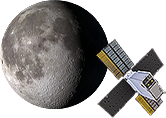
(text and background only visible when logged in)

(text and background only visible when logged in)
If all goes to plan, the stabilization process will take up to 10 minutes. And if everything checks out, Lunar Flashlight will activate its radio and begin transmitting a beacon back to Earth that says, basically, “I’m here, and I’m OK.”
The spacecraft will transmit telemetry data for 20 minutes — 10 minutes from an antenna on one end and 10 from one on the other end to ensure the message is received by the Deep Space Network. The collection of long-range antennas will lock onto the satellite's signal and connect the operations center in Atlanta to the spacecraft. Any faults or issues will display on the spacecraft link engineer’s computer screen in bright orange.
(text and background only visible when logged in)
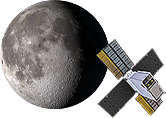
(text and background only visible when logged in)

(text and background only visible when logged in)
After listening for 20 minutes, mission controllers finally are able to transmit their first commands to the satellite. They’ll spend the next hour or so running through all the systems, making sure Lunar Flashlight is healthy and addressing any issues.
The satellite is carrying a relatively new kind of radio that’s powerful but gets hot while in its full duplex transmit-receive mode. That means mission control has about two hours of direct contact before the radio must be placed in a low-power, receive-only mode to cool off. So, controllers send a series of pre-programmed commands before switching to low power — including a final instruction to turn the radio back on after about eight hours. Forget that command, and the mission is in trouble.
(text and background only visible when logged in)

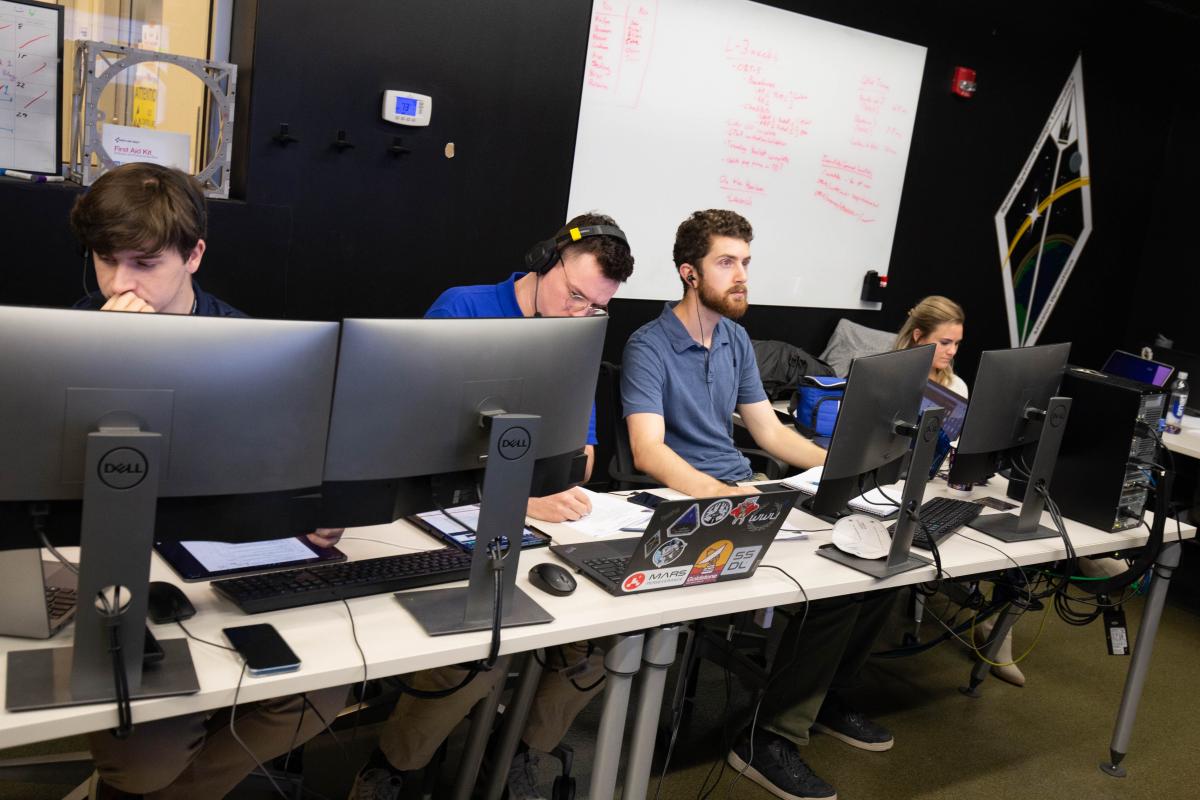

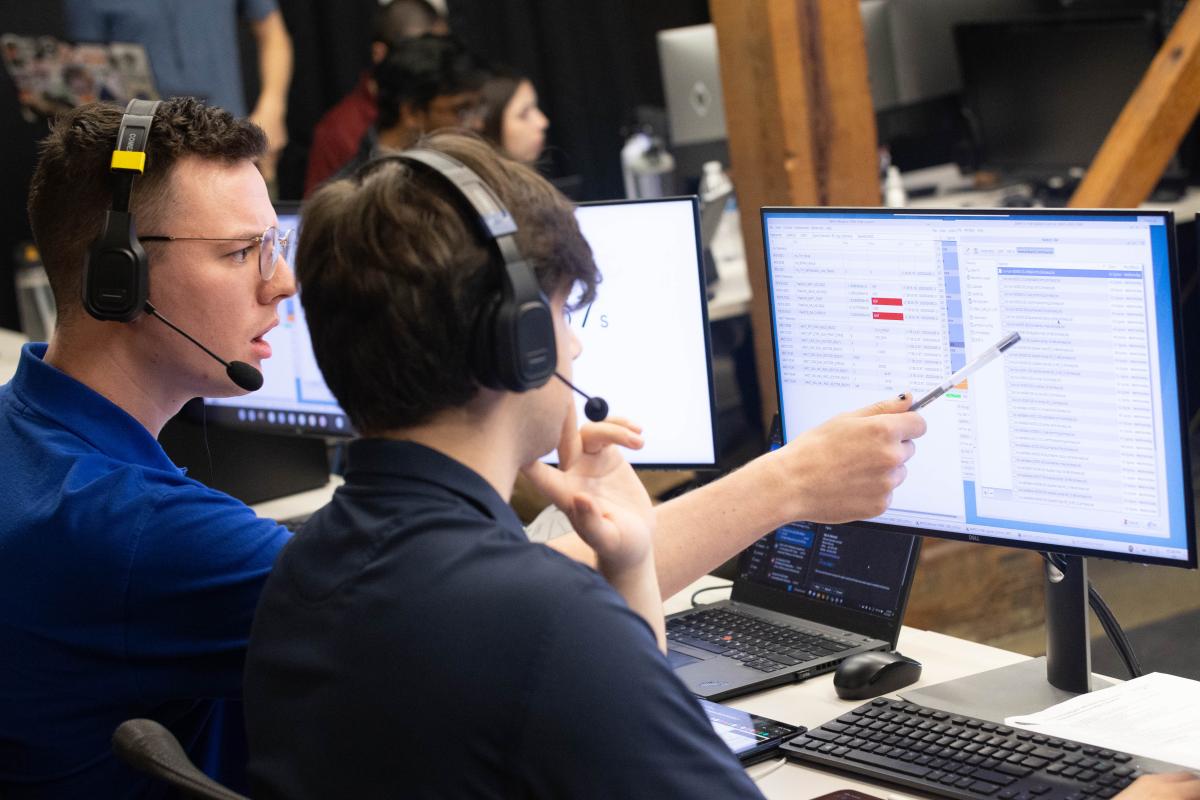
Missions Operations Lead Mason Starr led the Georgia Tech team in mission control through a series of Operational Readiness Tests ahead of the launch that will send Lunar Flashlight to the moon. In this trial in October, Starr (royal blue shirt) was joined in the controller positions by Conner Awald (left) and Michael Hauge. Other members of the team gathered in mission control to support the days-long test.
(text and background only visible when logged in)
(text and background only visible when logged in)
About 15 feet from where the team will "talk" to Lunar Flashlight is a table covered with a maze of wires and colorful electronics. Together, they are the guts of the satellite — working replicas of the components packed into the briefcase-sized spacecraft. This test bed allows mission control to troubleshoot and double check commands before they're beamed up to space.

(text and background only visible when logged in)
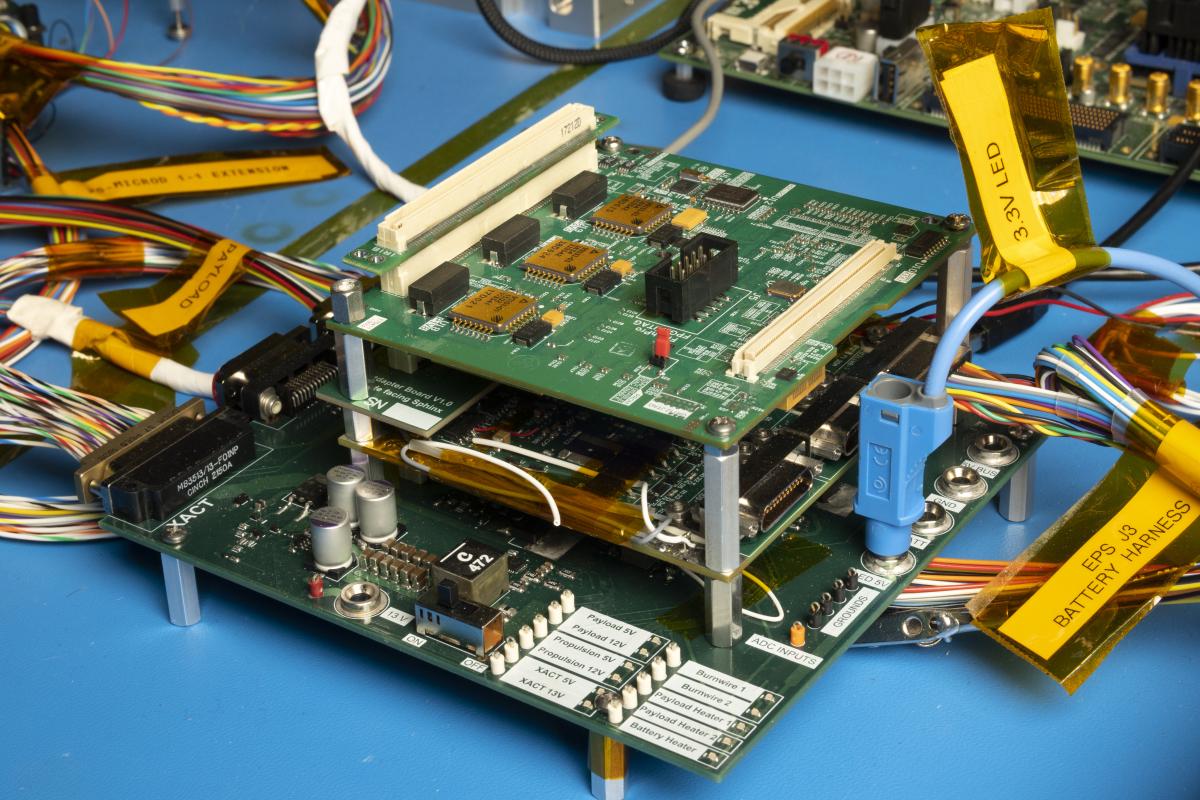
Control Electronics Stack
This contains the flight computer, or the brains of the spacecraft, along with the electronic power system card that routes power throughout Lunar Flashlight. The bottom of the stack is the interface board, which serves as a central hub: it connects to the rest of the devices within the satellite.
(text and background only visible when logged in)
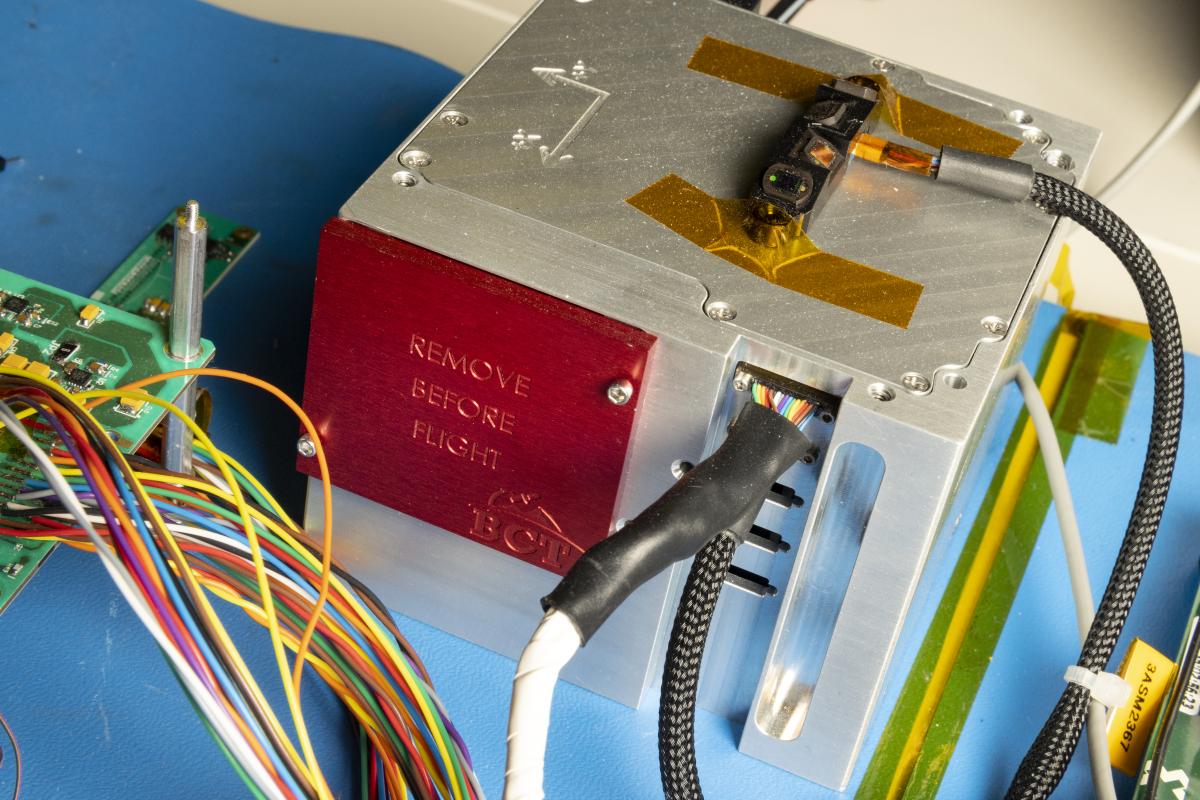
Attitude Control System
Three reaction wheels inside this device store angular momentum and provide necessary torque to control the spacecraft's orientation. On top is a small sun sensor that helps point the solar arrays at the sun. Lunar Flashlight also carries a star tracker that looks at a plot in the sky. By comparing it with a library of stars stored in its memory, Lunar Flashlight uses the cosmos to determine where it's pointed.
(text and background only visible when logged in)

Payload Electronics Boards
This pair of boards — one for analog electronics, the other for digital — controls the spacecraft's instruments while also storing the science data of each experiment. Of note: There are no lasers or detectors on the test bed, as they are highly specialized components designed to work in space.

Propulsion System FlatSat
The electronic components of the propulsion system are laid out on this board. They control the spacecraft's thrusters. Georgia Tech was contracted by Marshall Space Flight Center to build Lunar Flashlight's propulsion system.
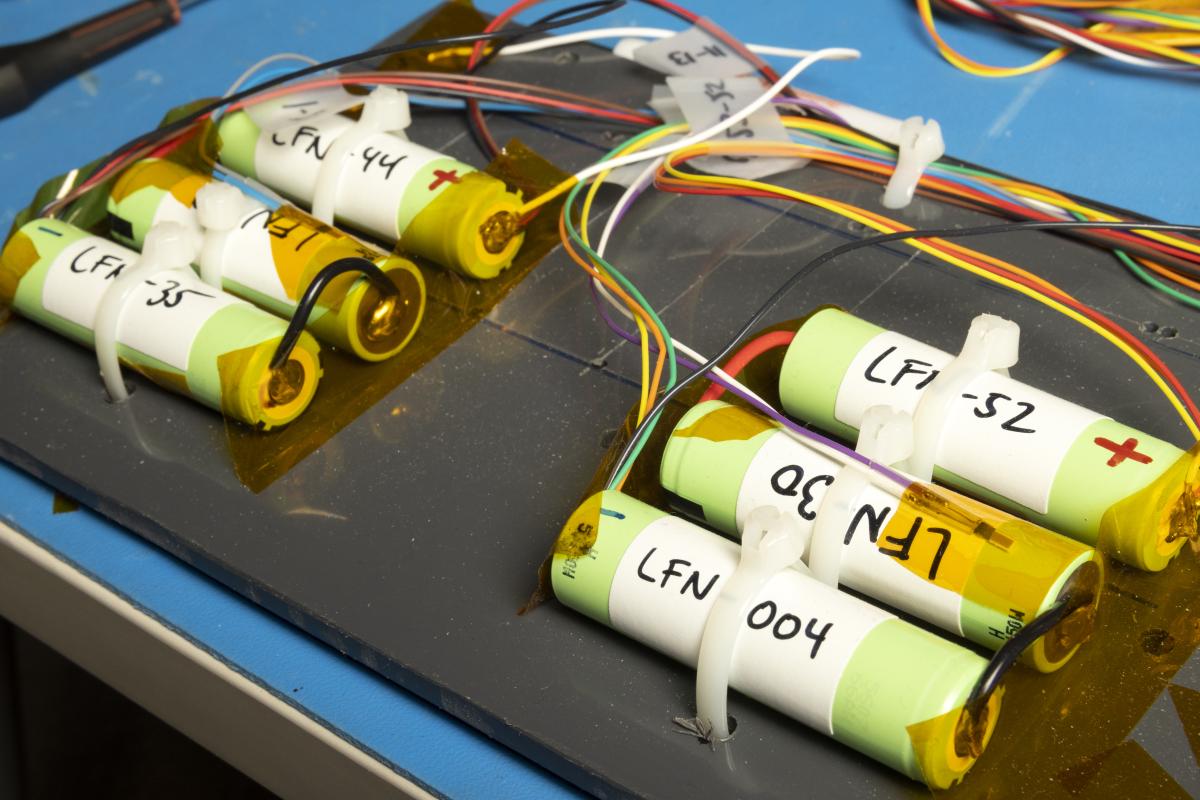
Battery Panel
The pack, with rechargeable batteries that can be bought in stores, powers the components on the test bed. In space, Lunar Flashlight's battery is recharged by four solar arrays.
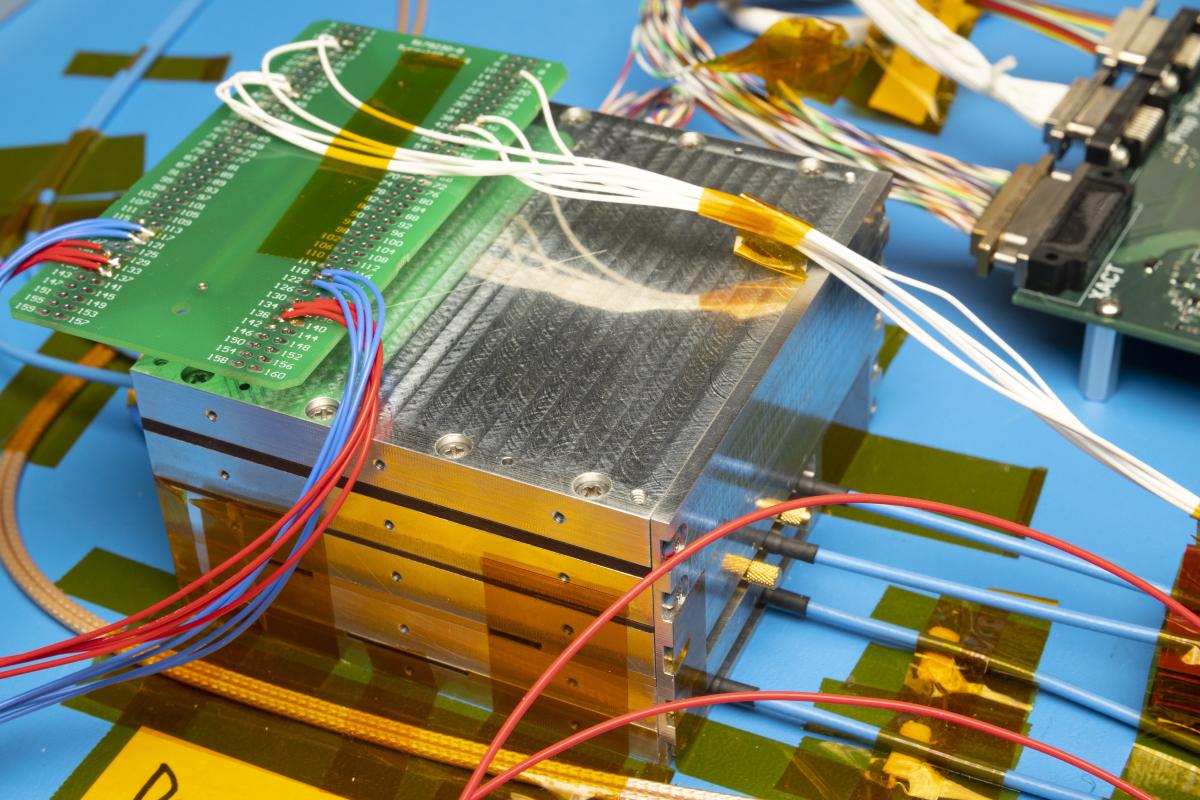
Radio
With two pairs of antennas — one on each side — Lunar Flashlight can receive commands from Georgia Tech via the Deep Space Network. The test bed version of the radio can send its signals through cables instead of antennas.
(text and background only visible when logged in)

(text and background only visible when logged in)
After a cooling-off period, mission control makes second contact with Lunar Flashlight. The objective now is to prime and commission the propulsion system — opening valves to move propellant into the system and lightly firing all the thrusters. Controllers want to see that the thrusters are working and at the proper temperatures.
One unique feature of the propulsion system designed by the team in AE is the propellant they’re using. Instead of hydrazine, long the reliable but toxic workhorse of space maneuvering, their system uses a new environmentally friendly fuel called ASCENT monopropellant. This mission is the first time this new propellant will be used to put a spacecraft in orbit around an object beyond Earth.
(text and background only visible when logged in)


These closeup images show the Georgia Tech-designed propulsion system in the lab. The system demonstrates a new technology and uses an improved environmentally-friendly propellant called ASCENT monopropellant. (Photos Courtesy: Conner Awald)
(text and background only visible when logged in)
(text and background only visible when logged in)
Georgia Tech's mission control will communicate with the Lunar Flashlight satellite through NASA’s Deep Space Network — a global network of radio antennas that allow operations teams to talk to all of the NASA and other agency interplanetary missions.
That means the satellite has to negotiate windows of time on the network’s limited bandwidth alongside space celebrities like the Voyager 1 and 2 probes now in interstellar space, Martian rovers, the James Webb Space Telescope, and payloads on the Artemis moon missions.
(text and background only visible when logged in)

(Courtesy: NASA/JPL-Caltech)
(text and background only visible when logged in)

(text and background only visible when logged in)
The primary objective of the third contact is to use the thrusters to perform what’s called a “momentum dump.” This will slow the reaction wheels inside the spacecraft that keep it stable and pointed in the right direction.
(text and background only visible when logged in)
(text and background only visible when logged in)
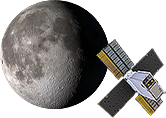
(text and background only visible when logged in)

(text and background only visible when logged in)
Around 50 hours after deployment, the Lunar Flashlight team will perform their first big burn of the propulsion system. Called a “trajectory correction maneuver,” or TCM, the burn is designed to put the satellite on the proper course toward the moon.
(text and background only visible when logged in)
(text and background only visible when logged in)
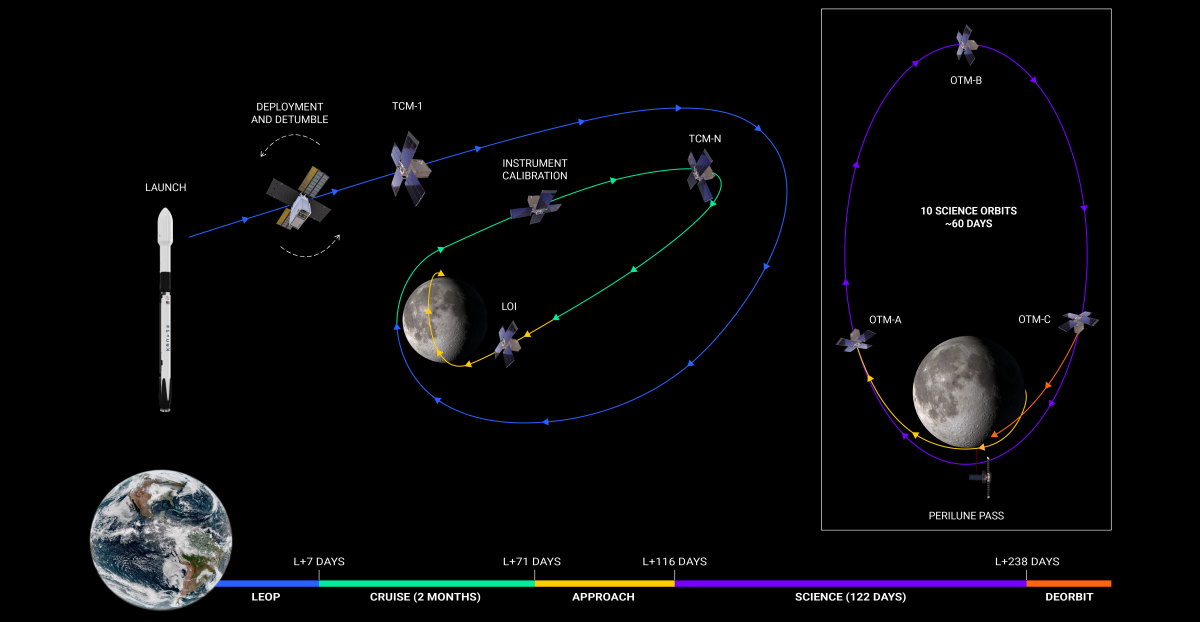
This illustration shows the full Lunar Flashlight mission trajectory, from launch to lunar orbit insertion (LOI), on the left. The inset depicts the spacecraft's long, elliptical lunar orbit during the science missions, when Lunar Flashlight will use lasers to scan for ice in permanently shadowed regions of the moon's south pole. (LEOP = launch and early operations phase; TCM = trajectory correction maneuver, when the propulsion system will fire; LOI = lunar orbit insertion; OTM = orbital trim maneuver, when the propulsion system fires to maintain the proper lunar orbit)
(text and background only visible when logged in)
(text and background only visible when logged in)
Lunar Flashlight won’t fly directly from Cape Canaveral to the moon. Without people aboard in need of food and water — and a small payload of fuel — the spacecraft will chart a long path that actually extends beyond the orbit of the moon to minimize fuel consumption.
The trajectory means the satellite will already be traveling almost the right speed in a few months when it executes the critical lunar orbit insertion maneuver necessary to begin its science work. Unlike a human-carrying spacecraft, Lunar Flashlight won't have to burn significant fuel to slow down when it reaches the moon.
(text and background only visible when logged in)

(text and background only visible when logged in)
This contact marks the end of an intense week of tests, health checks, and preparations. Lunar Flashlight will fire up the Georgia Tech-designed propulsion system again for another trajectory correction maneuver — TCM-2. This burn will correct for any errors from the first trajectory correction maneuver a few days earlier.
(text and background only visible when logged in)
(text and background only visible when logged in)
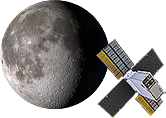
(text and background only visible when logged in)

(text and background only visible when logged in)
Once the second propulsion burn is complete, Lunar Flashlight enters a quieter cruise status for the nearly four-month trip and approach to the moon.
The students in mission control will check in on the little satellite roughly once a day to make sure the journey is going smoothly, including executing additional small propulsion burns to stay on course.
Along the way, the team also has a chance to run Lunar Flashlight’s scientific instrument through a series of benchmarks — after all, it's been tested in labs on Earth but never in the cold vacuum of space.
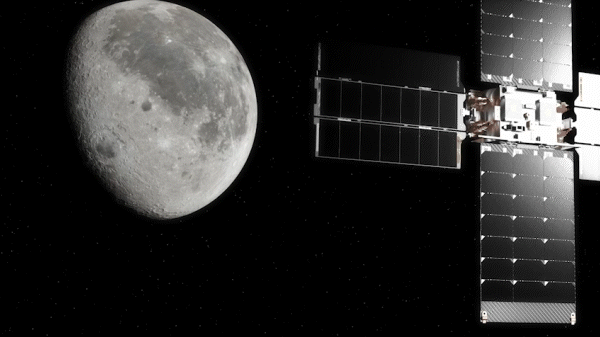
(Courtesy: NASA/JPL-Caltech)
(text and background only visible when logged in)
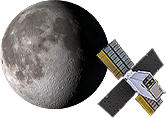
(text and background only visible when logged in)

(text and background only visible when logged in)

(Courtesy: NASA/JPL-Caltech)
Lunar Flashlight is scheduled to reach the moon late in the spring semester. Once it does, Georgia Tech’s mission control again will buzz with activity as data comes in from 10 planned orbits of the moon over the course of 60-90 days.
Controllers will be in contact with the spacecraft two or three times a week during the science orbits, ensuring everything is working properly and passing the Lunar Flashlight telemetry to JPL in Pasadena, California, and the science data to the Science Operations Center at the University of California, Los Angeles.

Space (& Beyond) at Georgia Tech's College of Engineering

To the Moon, Back, and Beyond: Why the Moon Matters
Georgia Tech experts discuss why we are returning to the lunar surface, what we might find there, what it might mean for international politics, and why the moon matters for the future of space exploration.
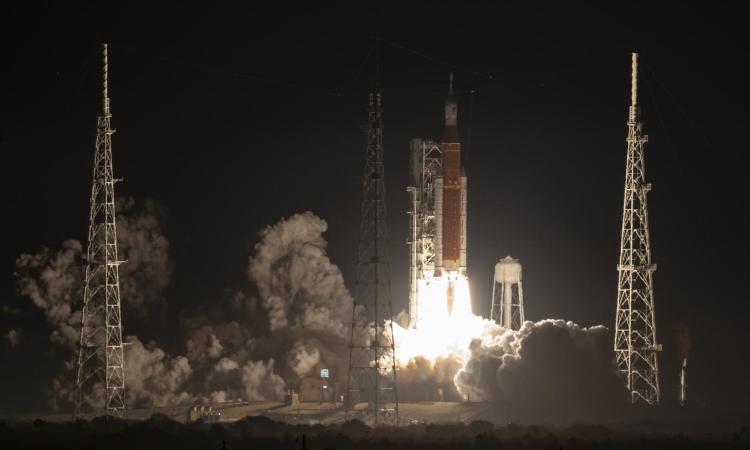
Artemis Begins a New Era in Space
Georgia Tech astronaut Sandy Magnus talks about the Artemis mission, America's return to the moon, and the opportunities it presents to the next generation of explorers.
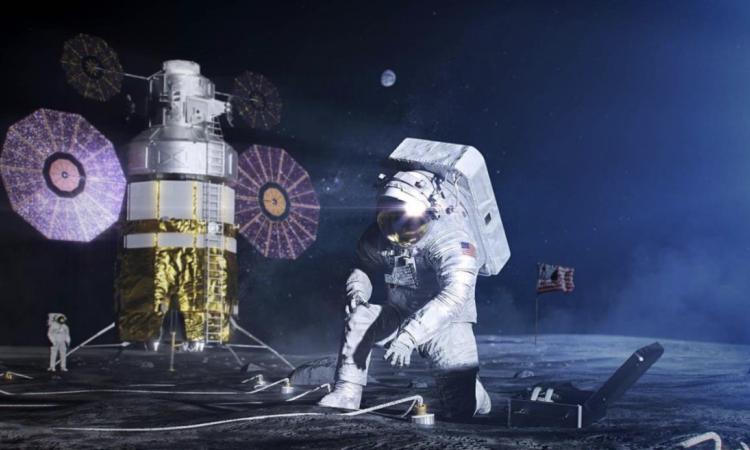
The Future of Space Exploration
Georgia Tech points to what’s next, and how the Institute will contribute.
GTRI's SEEDLab Ground Zero for Lunar Flashlight Project
Students used the SEEDLab makerspace to create a 1:1 model of the satellite.
(text and background only visible when logged in)
